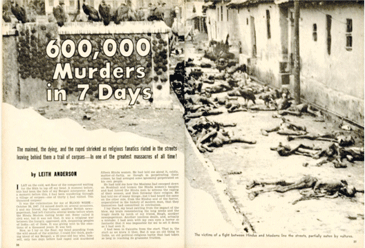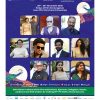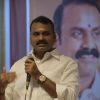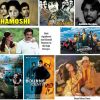Goa is abuzz with excitement as vintage bike and car owners, users, collectors and fans are decking […]

‘THE KASHMIR FILES’ DISTORT HISTORY! BY ANURAG MINUS VERMA
Mar 26- Apr 01 2022 March 25, 2022DISTORTED: The film ‘The Kashmiri Files’ remains silent on the killing of 6,00,000 Muslims in Jammu in 1947.Who killed them?
By Anurag Minus Verma
The film ‘The Kashmiri Files’ made by a hard core Hindutva film producer, Vivek Agnihotri, is part of the agenda for polarising India along communal lines. The film talks about how 84 Kashmiri families driven out of Kashmir but remains silent on Kashmiri Muslims killed by Muslim terrorists
The Kashmir Files has given major FOMO to many people who believe the film contains some grand truth that they are missing out on. Many Indian audiences made a pilgrimage to the theatres to open their ‘third eye’ and witness ‘the truth’ in its pure and organic form. Passions and emotions ran high in theatres and there were many videos circulating on social media where audiences were seen delivering long speeches as the end title rolled on the screen. Cinema halls are known to give ‘audiences to the filmmaker’ but this film is unique because it gave ‘audiences to audiences’.
A few days ago, Prime Minister Narendra Modi said, with regards to the film, that the entire ‘ecosystem’ worked to hide the truth, and that “a truth suppressed for so long is coming out.” In a Roger Ebert-ian fashion, he gave ‘two thumbs up’ to the film and recommended the film to his MPs. This is a significant recommendation from the head of the country. This creates more suspense about the ‘truth’ that this film claims to possess.
There is now a growing debate where the Right-wingers are saying that ‘propaganda’ of the Left and the liberals (whom they have nicknamed ‘Urban Naxal’) is ‘busted’ and the ‘truth’ is finally being told through cinema. On the other hand, people from opposing ideologies believe that The Kashmir Files is nothing but State-sponsored propaganda. This itself leads to the question: what is the meaning of propaganda in cinema and can we distinguish between ‘good propaganda’ and ‘bad propaganda’?
To answer this question, we need to turn to the history of cinema.
Montage films of Soviet Cinema
The Russian Revolution of 1917 created a political environment that pushed the role of propaganda in cinema. The word ‘propaganda’ at that time didn’t have the negative connotation it has today.
In fact, propaganda was termed as an ‘essential activity’ to spread awareness among the public and ‘stimulate their revolutionary thoughts’. Many great filmmakers emerged in this era who believed in the power of propaganda and they made films that are considered some of the most important artworks in cinematic history. These were filmmakers who gave many film theories that are still taught across the best film schools in the world. Among them, the most prominent is Soviet director Sergei Eisenstein who gave ‘montage theories’ or editing techniques. Most modern editing techniques currently used in Hollywood and Bollywood owe a lot to Eisenstein and Lev Kuleshov’s theories of editing.
As such, the base of cinematic editing techniques lies in the idea of propaganda. No wonder famous French filmmaker Jean-Luc Godard once remarked: “Cinema is truth 24 times a second, and every cut is a lie.” There is a medium of psychological manipulation through the use of editing that every filmmaker uses to present their ideas or ‘truth’ to the public.
Now comes the classic question of ‘good propaganda’ and ‘bad propaganda.’ How can we define ‘propaganda’ when it is inherent to cinema? Can ‘good propaganda’ be termed as the transmission of ideas that expand the mind of an individual and thus contribute to society and bad propaganda as something that restricts the thinking of an individual and converts him to a hateful person? Beth Bennett and Sean O’Rourke (2006) thus “contrast ‘good’ rhetoric, which they claim appeals to reason, with ‘bad’ propaganda, which they claim appeals to the emotions,” as noted by researcher Michael Russel in his 2009 thesis.
Relationship between propaganda and spectators
Any success of propaganda also tells us the relationship between the propaganda-makers and the target audiences. In order for propaganda films to land successfully, a proper launching ground first needs to be created. The Kashmir Files is a classic film for its time and place — in a hyper-nationalistic era, where the Right-wing machinery is working overtime to seize the ‘means of communication’ (whether it’s news channels, social media, or Internet memes); in today’s time when there is unadulterated hate against JNU (Jawaharlal Nehru University) and intellectuals; in this era when bigotry is on free display even by the heads of the states. This is the perfect time for such a film to arrive — the audiences are already in a trance of misinformation and they just want to go to the theatres to stamp their prejudices rather than seek ‘truths’.
This is why videos of people shouting slogans in theatres and openly making hate speeches against Muslims abound social media. The Kashmir Files is, in fact, a social-political film where you’ll gain more insight about society if you shift your gaze away from the white screen of the cinema hall and observe the audience.
A film professor from my alma mater Film and Television Institute of India (FTII) used to say: “The meaning of the film is already in the mind of the public and as a filmmaker, you just need to tap into that subconscious area.” This is the reason people interpret films based on their own realities and truths that they have constructed. In the case of The Kashmir files, Kashmiri Hindus are rightfully ‘relating’ to the film because this is a rare occasion when the stories of unimaginable, horrific tragedies are presented on celluloid. On the other side, some people are ‘relating’ to the film because it confirms their biases against those they hate. This is the kind of film that doesn’t ‘tell’ but rather ‘sells’ the idea of truth to you.
American writer Susan Sontag once remarked: “If cinephilia is dead, then movies are dead too… No matter how many movies, even very good ones, go on being made. If cinema can be resurrected, it will only be through the birth of a new kind of cine-love.”
The Kashmir Files also got released post-lockdown, where the intimate experience of individual watching shifted once again to collective viewing in cinema halls. Here, the cinema hall itself became a space for a national experiment, where ‘we’, the people, flocked together to experience the moving images. In the cinema hall, Kashmiri Pandits became emotional watching the film and hugged each other as an act of shared trauma, whereas many collective haters shouted angry slogans to show that, as a nation, we are together in shared anger against people who allegedly hid the truth for long.
Cinema as a truth-telling medium
This trend of bringing out the ‘truth’ of any historical event through the cinematic medium is a complicated thing to do. Cinema can only bring out one version of the truth, which itself is deeply marinated in the biases of the person telling the story or people sponsoring the film. In cinema, every frame is political by default because by choosing what’s inside the frame, you are, automatically, hiding what’s outside of it. The very frame that your camera chose tells something about the ‘gaze’ and mind of the person who conceptualised it. This is why rather than the accuracy of events presented in the film, what matters the most is how these events are presented to create a psychological effect. How does the film play with the emotion of pre-radicalised society through the usage of cinematic mediums?
There is also a difference between political cinema and politically motivated cinema. The Kashmir Files is the latter, using propaganda to shut minds off rather than stimulate any useful cinematic or social thoughts.
However, an unexpected, and probably undesired, byproduct happens to be the catharsis for Kashmiri Pandits who feel they have ‘witnessed’ their truth being told, ironically through fiction, for we, as a society, talk more about Kashmiri Pandits than talking to them or humanely understanding their plight.
Anurag is a multimedia artist and host of Anurag Minus Verma Podcast. He tweets @confusedvichar. Views are personal.
(Edited by Srinjoy Dey)
Courtesy : The Print















